Assam is a stunning region, one of the Seven Sisters of the North East. Assam is not merely a young state; it also has strong cultural roots, and its residents enjoy following those customs and cultures. The tranquillity, verdant forests of this state, and how people dress traditionally contribute to its beauty. In this article, you can go into great detail on traditional Assamese attire for both genders.
Traditional Dress of Assam for Female:
Mekhela Chador: The most common and extensively worn traditional clothing among Assamese women is the mekhela chador. The Mekhela and the Chador make up its two halves. A cylindrical fabric called a mekhela is worn as the bottom garment. It is wrapped about the waist and secured with pleats. The Chador covers the upper body, a long, rectangular piece of clothing slung over the shoulder. Mekhela Chador is often made of silk and has elaborate patterns and motifs influenced by flowers, birds, and other natural elements. It is frequently used for weddings, festivals, and other important occasions and is embroidered exquisitely.
Riha: Another traditional outfit worn by Assamese women is the riha, mostly in the native areas. It is a three-piece outfit made up of a stole identified as Seleng, a skirt referred to as Dokhna, and a shirt called Riha. The Dokhna is a wraparound skirt, whilst the Riha is a short-sleeved blouse. A long, rectangular stole called a selling is worn about the waist. Typically composed of cotton or silk, the Riha features vibrant designs and patterns that reflect the cultural identities of various groups.
Pat Silk Saree: The Pat silk saree is a fine example of Assamese handicraft. Assam is known for its beautiful silk manufacture. It is distinguished by its vivid hues, dexterous borders, and ornate pallu. The Pat silk saree, worn for weddings, festivals, and other important occasions, is regarded as the pinnacle of grace and elegance.
Traditional Dress of Assam for Male:
Dhoti-Gamosa: The traditional outfit for males in Assam is a dhoti and gamosa. As the lower garment, the dhoti is a rectangular cloth worn about the waist. A samosa, a conventional cotton towel with red borders, is placed next to it. The gamosa can be worn as a headpiece or placed around the neck. Dhoti and gamosa together symbolize the traditional uniqueness and simplicity of Assamese men.
Muga Jacket: Muga silk is a unique type of silk made in Assam and is prized for its golden lustre and tenacity. Assamese men dress in Muga jackets, especially during religious and ceremonial celebrations. It is a waist-length Muga silk jacket with elaborate patterns and decorations. The Muga jacket gives the wearer’s appearance a touch of regalness and is frequently worn with a dhoti or kurta.
Gamosa: Despite being mainly utilized as a towel; the gamosa has tremendous cultural significance in Assam. It is a rectangle of red-bordered cotton fabric that has traditional motifs and patterns all over it. During traditional rites and festivals, the gamosa is donned as a decorative item around the neck or fastened to the waist and used as a hand towel.
Tribal Wear of Assam
The Dimasa Tribe
The Sgaopha or Phagri (a turban) that the males of the Dimasa tribe are referred to wear symbolises the pride they have in their name. The Sgaopha is often yellow or green; however, on important days like weddings, the groom dons a white turban with a crimson ribbon tied beneath the chin. These individuals travel with a small muffler called a rigid. Both Risha and Gainthao are Dhotis. However, they are of different lengths. The Gainthao reaches the ankle while the Risha approaches the knee.
The Bodo Tribe
The men of the Bodo tribe are casual dressers and are often seen donning the Gamosa, which is the typical attire of Assam. The top half of the body was intended to remain exposed and is covered by the gamosa from the waist to the knee. But one thing that sets the males of the Bodo tribe apart is their footwear. Before recently, they wore what was referred to as Khorom, footwear constructed from wood.
The Mishing Tribe
One of the tribes that adhere to Assam’s uniform code is the missing tribe. The Gonru Ugon, a Dhoti, a piece of clothing worn from the waist down, is what the tribe’s men wear. Men conceal their upper bodies with malibu taluk, a shirt-like garment.
The Rabha Tribe
The Rabha Tribe’s members have a strong attachment to their traditions and a distinctive sense of style whenever it comes to how the women of the tribe dress. The men, nevertheless, dress according to the traditional Dhoti and Gamosa Assamese attire.
Conclusion
Both men’s and women’s traditional Assamese clothing displays the region’s cultural diversity, artistic talent, and rich legacy. These outfits not only look good, but they also represent the Assamese individual pride and identity. Assam’s traditional clothing, whether the elegant Mekhela Chador for women or the straightforward yet stylish dhoti games for men, is essential to the state’s cultural heritage.

Santosh Kumar is an editor at unfoldstuffs.com and a professional content writer. With years of experience he is passionate for creating engaging, informative and impactful topics.










